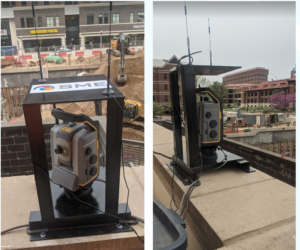
Protecting Infrastructure through Multiservice Collaboration
SME® | Published on March 19, 2025

Although it’s not apparent to the naked eye, the world and everything built on it is moving all the time. These movements are a result of many factors, some of which are relatively unknown (such as variable soil performance) or not often measured. Movements of a fraction of an inch aren’t detectable through personal observation, but they can lead to undesired consequences, such as cracked masonry and injuries, if left unchecked.
In a recent episode of SME’s Build+Revitalize podcast, Ryan Eiss, one of our Project Consultants, discussed how the data from real-time monitoring can show the various causes of building movement and how our multiservice approach can provide fast, accurate recommendations in these situations. Our team’s real-time data interpretations allow owners to understand how infrastructure, whether it’s an office building or a bridge, behaves under different circumstances. The goal is informed decision-making at every step.
Understanding Thermal Expansion
Thermal expansion refers to the way materials expand and contract due to temperature changes. This phenomenon can cause natural movement in structures which need to be accounted for when monitoring displacement of a structure. For instance, a temperature shift from a 30-degree night to an 80-degree day might create a natural movement of ¼ of an inch or more depending on the structure. Our team uses real-time data to monitor such movements and determine their causes accurately.
For example, SME was monitoring the construction of a tunnel between two buildings. One of the building’s exterior columns was temporarily being supported by a hydraulic jack. During construction, unexpected movement was picked up by our real-time monitoring equipment. The construction crew initially thought the hydraulic jack was failing, raising concerns about the building. However, our team, headed up by a surveyor and a geotechnical engineer, derived a different conclusion from the data: the heat of the day was causing the column to expand into the jack, increasing the pressure reading. Instead of a design or structural failure, the column movement was natural and due to the change in temperature rather than construction induced movement. Through careful analysis of the data both past and present, our team was able to inform the contractor about what was happening and continue the project safely.
Real-Time Monitoring in Action
Another example of how SME’s service groups collaborate using real-time data involved a project where the contractor was underpinning the foundation of a large column. Part of the way through, our monitoring equipment showed an alarm indicating that the column was raising up, which seemed impossible due to gravity.
Once again, our Survey and Geotechnical teams compared data and combined their expertise to quickly assess the odd situation. The cause became apparent: the construction team was grouting underneath the column, causing it to rise. After SME communicated this to the contractor, they immediately stopped the work, allowed the column to settle, and resumed grouting at a much slower pace.
Vibration monitoring also provides real-time data on construction activity. This service usually runs for the duration of construction and notifies the project team if vibrations exceed a certain threshold and could become strong enough to impact surrounding infrastructure, as Seth Molenaar discussed in SME’s Build+Revitalize podcast.
While typical surroundings might include commercial buildings, residences, or existing structures on the project site, they can also be unique challenges. For instance, a recent expansion project SME worked on involved a property’s lakefront. The project team noted that installing the expansion’s foundation might affect the in-place lakefront’s battered piles, which angle away from the lakefront to brace the seawall against the water. The new foundation’s auger-cast piles could impact the batter piles during installation.
SME’s innovative solution was to place vibration monitoring units on the seawall, near the end of the battered piles. The units would pick up any vibrations if the drilling operations for foundation’s auger-cast piles impacted the battered piles. The vibration units monitored every second of activity in real time, allowing the team to know if the seawall was impacted at any point.
The Power of Collaboration
At SME, our teams monitor and interpret data together, enabling us to make informed decisions faster. Real-time data monitoring, combined with the expertise of our team members, allows us to protect infrastructure and deliver successful outcomes for our clients.





